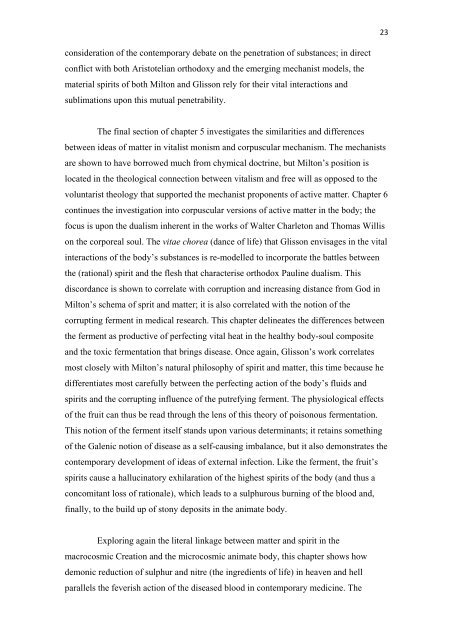Medical Science and the Anatomia Animata in Milton's Paradise Lost
Medical Science and the Anatomia Animata in Milton's Paradise Lost
Medical Science and the Anatomia Animata in Milton's Paradise Lost
Create successful ePaper yourself
Turn your PDF publications into a flip-book with our unique Google optimized e-Paper software.
consideration of <strong>the</strong> contemporary debate on <strong>the</strong> penetration of substances; <strong>in</strong> direct<br />
conflict with both Aristotelian orthodoxy <strong>and</strong> <strong>the</strong> emerg<strong>in</strong>g mechanist models, <strong>the</strong><br />
material spirits of both Milton <strong>and</strong> Glisson rely for <strong>the</strong>ir vital <strong>in</strong>teractions <strong>and</strong><br />
sublimations upon this mutual penetrability.<br />
The f<strong>in</strong>al section of chapter 5 <strong>in</strong>vestigates <strong>the</strong> similarities <strong>and</strong> differences<br />
between ideas of matter <strong>in</strong> vitalist monism <strong>and</strong> corpuscular mechanism. The mechanists<br />
are shown to have borrowed much from chymical doctr<strong>in</strong>e, but Milton’s position is<br />
located <strong>in</strong> <strong>the</strong> <strong>the</strong>ological connection between vitalism <strong>and</strong> free will as opposed to <strong>the</strong><br />
voluntarist <strong>the</strong>ology that supported <strong>the</strong> mechanist proponents of active matter. Chapter 6<br />
cont<strong>in</strong>ues <strong>the</strong> <strong>in</strong>vestigation <strong>in</strong>to corpuscular versions of active matter <strong>in</strong> <strong>the</strong> body; <strong>the</strong><br />
focus is upon <strong>the</strong> dualism <strong>in</strong>herent <strong>in</strong> <strong>the</strong> works of Walter Charleton <strong>and</strong> Thomas Willis<br />
on <strong>the</strong> corporeal soul. The vitae chorea (dance of life) that Glisson envisages <strong>in</strong> <strong>the</strong> vital<br />
<strong>in</strong>teractions of <strong>the</strong> body’s substances is re-modelled to <strong>in</strong>corporate <strong>the</strong> battles between<br />
<strong>the</strong> (rational) spirit <strong>and</strong> <strong>the</strong> flesh that characterise orthodox Paul<strong>in</strong>e dualism. This<br />
discordance is shown to correlate with corruption <strong>and</strong> <strong>in</strong>creas<strong>in</strong>g distance from God <strong>in</strong><br />
Milton’s schema of sprit <strong>and</strong> matter; it is also correlated with <strong>the</strong> notion of <strong>the</strong><br />
corrupt<strong>in</strong>g ferment <strong>in</strong> medical research. This chapter del<strong>in</strong>eates <strong>the</strong> differences between<br />
<strong>the</strong> ferment as productive of perfect<strong>in</strong>g vital heat <strong>in</strong> <strong>the</strong> healthy body-soul composite<br />
<strong>and</strong> <strong>the</strong> toxic fermentation that br<strong>in</strong>gs disease. Once aga<strong>in</strong>, Glisson’s work correlates<br />
most closely with Milton’s natural philosophy of spirit <strong>and</strong> matter, this time because he<br />
differentiates most carefully between <strong>the</strong> perfect<strong>in</strong>g action of <strong>the</strong> body’s fluids <strong>and</strong><br />
spirits <strong>and</strong> <strong>the</strong> corrupt<strong>in</strong>g <strong>in</strong>fluence of <strong>the</strong> putrefy<strong>in</strong>g ferment. The physiological effects<br />
of <strong>the</strong> fruit can thus be read through <strong>the</strong> lens of this <strong>the</strong>ory of poisonous fermentation.<br />
This notion of <strong>the</strong> ferment itself st<strong>and</strong>s upon various determ<strong>in</strong>ants; it reta<strong>in</strong>s someth<strong>in</strong>g<br />
of <strong>the</strong> Galenic notion of disease as a self-caus<strong>in</strong>g imbalance, but it also demonstrates <strong>the</strong><br />
contemporary development of ideas of external <strong>in</strong>fection. Like <strong>the</strong> ferment, <strong>the</strong> fruit’s<br />
spirits cause a halluc<strong>in</strong>atory exhilaration of <strong>the</strong> highest spirits of <strong>the</strong> body (<strong>and</strong> thus a<br />
concomitant loss of rationale), which leads to a sulphurous burn<strong>in</strong>g of <strong>the</strong> blood <strong>and</strong>,<br />
f<strong>in</strong>ally, to <strong>the</strong> build up of stony deposits <strong>in</strong> <strong>the</strong> animate body.<br />
Explor<strong>in</strong>g aga<strong>in</strong> <strong>the</strong> literal l<strong>in</strong>kage between matter <strong>and</strong> spirit <strong>in</strong> <strong>the</strong><br />
macrocosmic Creation <strong>and</strong> <strong>the</strong> microcosmic animate body, this chapter shows how<br />
demonic reduction of sulphur <strong>and</strong> nitre (<strong>the</strong> <strong>in</strong>gredients of life) <strong>in</strong> heaven <strong>and</strong> hell<br />
parallels <strong>the</strong> feverish action of <strong>the</strong> diseased blood <strong>in</strong> contemporary medic<strong>in</strong>e. The<br />
23
















